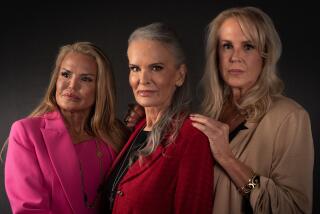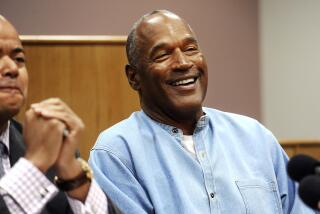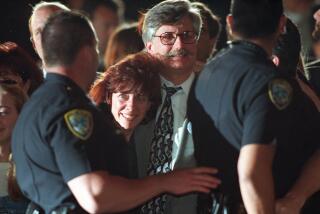NEWS ANALYSIS : Prosecutors See Simpson Image as Key Problem
- Share via
When you look at the list of the first dozen witnesses prosecutors intend to call in O.J. Simpson’s double-murder trial, it’s clear exactly what Deputy Dist. Atty. Marcia Clark and her colleagues think their biggest problem is--and how they plan to overcome it.
Their difficulty, they believe, is that the accused killer of Nicole Brown Simpson and Ronald Lyle Goldman is well-known and well-liked. In fact, as author John Gregory Dunne put it recently, Simpson is “the quintessential intimate stranger, the person we think we know because of his celebrity.”
The prosecutors’ solution to this problem, their initial witness list suggests, is to convince the jurors that, however “intimate” their electronic acquaintance, the real O.J. Simpson was indeed a stranger. He was, they will seek to prove, a man his fans never knew--one who repeatedly abused his wife.
If jurors believe such abuse occurred, experienced lawyers agree, they are more likely to entertain the possibility that the man they once cheered had slashed the throats of his ex-wife and her friend.
Still, legal analysts from both sides of the aisle agreed that the prosecutors’ strategy is--like so much of the case--novel. “The usual approach would be to start at the crime scene with a witness who discovers the bodies or one of the police officers, someone who focuses attention on the crime itself,” said Loyola law professor Samuel H. Pillsbury, a former federal prosecutor. “What they have decided is that they have to make a pitch to the hearts and the minds of the jury. They’re going for the hearts first with the abuse evidence, trying to convince the jury that Simpson is a violent person.”
Los Angeles defense attorney Gerald L. Chaleff agrees. “At first blush, I’m surprised,” he said. “In every case of this sort that I’ve tried, the prosecution has begun with the brutal facts of the crime itself. In this instance, however, they appear to believe that their biggest problem is getting the jury to connect the O.J. Simpson the jurors think they know to a crime of this sort.
“Obviously, they think that no matter how strong the scientific evidence may be, they’re not confident that a jury would convict the O.J. Simpson that they’ve seen on television. So, their intention is to immediately recast his character.”
Clearly, that was what Simpson’s lead defense lawyer, Johnnie L. Cochran Jr., was trying to forestall Monday when he presented a timeline designed to show that Simpson could not have committed the crime. He reminded jurors that, if Simpson lacked time to kill, “then the character evidence means nothing.”
In fact, California law specifies that prosecutors are not permitted to present evidence simply to show someone has a bad character. They can, however, offer evidence of uncharged acts that tend to show motive, opportunity, planning, knowledge and identity.
Under that theory, Clark and her colleagues intend to kick off their case with testimony concerning Simpson’s 1989 attack on his then-wife, then move to a similar incident in 1993, sources close to the case said. They intend to play as much of the audiotapes of both events as Superior Court Judge Lance A. Ito will allow. After that, the sources say, they’ll put on Nicole’s former lover Keith Zlomsowitch, her sister Denise Brown and former Los Angeles Police Officer Ron Shipp, who says he confronted Simpson over his wife-beating.
Ito specifically permitted the prosecution to present all of this evidence after vigorous defense efforts to keep it away from the jury, contending that the incidents were either irrelevant to the murder case or unfairly prejudicial or both. One of the first witnesses is expected to be Officer J. Edwards, who was among the officers who responded to the Simpson house early in the morning of Jan. 1, 1989, after Nicole Simpson called 911, saying she had been beaten.
Upon seeing police, she yelled: “He’s going to kill me! He’s going to kill me!” When the officer asked Nicole Simpson who was going to kill her, she responded, “O.J.,” according to police records cited in prosecution briefs.
Other officers and a dispatcher will talk about the much-discussed Oct. 25, 1993, incident during which Nicole Simpson screams as a man she identifies as her ex-husband breaks down the back door of her Brentwood condominium.
Zlomsowitch is expected to testify about three incidents in which Simpson allegedly stalked his former wife.
Nicole Simpson’s sister, Denise Brown, probably will be asked about an incident from the summer of 1989. Prosecutors say Denise Brown and others at a bar observed Simpson grab “Nicole by the crotch and (shout), ‘This belongs to me. This is where my children come from.’ ” Later, according to a prosecution brief, Denise saw Simpson strike Nicole and push her from a moving car.
Shipp, who served with the LAPD from 1974 until he resigned in October, 1989, may be of particular importance because he was a friend of the Simpsons and one of the first people to whom Nicole Simpson allegedly confided incidents of domestic abuse, according to a source close to the case. The source confirmed an account reported in a new book about the Simpson marriage by author Sheila Weller, “Raging Heart.”
After the New Year’s Day, 1989, incident, Simpson enlisted Shipp--who was then teaching a class on domestic abuse at the Police Academy--to smooth things over with his estranged wife.
When Shipp went to intercede for Simpson, however, Nicole Simpson pulled out several photos of bruises and injuries she said she had suffered during previous fights with Simpson, the source said.
At that point, Shipp tried to mediate between the couple, even confronting Simpson with materials from the LAPD class and urging him to accept responsibility as a batterer, the book and source said.
To San Diego Deputy Dist. Atty. Donald J. MacNeil, the potential impact of such testimony could be critical. “We live in a society where appearances count. Even though we know you can’t judge a book by its cover, people make lots of important decisions based on appearances.
“As a consequence, the prosecution--in a very compressed period of time--has to reveal a very small part of this person’s private side, a side which neither he nor his friends nor his sponsors nor his employers ever had an interest in exposing to the public,” MacNeil said.
But to Los Angeles defense lawyer Charles R. English, who has defended such celebrity clients as Jack Nicholson, James Woods and Tupac Shakur, the prosecutors’ tactic is “risky. . . . If it all falls apart, the jurors are likely to be even more skeptical of the scientific evidence.”
Defense attorney Marcia Morrissey makes a more pointed criticism. “It’s character assassination,” she said. “ It’s an attempt to begin their case by making O.J. Simpson look like a despicable wife-beater. If you have a weak case factually on the murder charges--which they’re acting as though they do--then you want to try and bolster that case by calling the defendant names and by trying to prove that he’s a bad person. This, in turn, plays on the jury’s natural inclination to think that bad people do bad things--i.e., murder.
“What amazes me about this and the whole discovery flap is that the prosecution is acting like it’s scared to death.”
Former Los Angeles County Dist. Atty. Ira Reiner also sees prosecutorial anxiety. “What the prosecutors see as their biggest problem is trying to persuade the jury that O.J. Simpson is capable of murder. They have their apple cart full of evidence, but they’re afraid any little thing can tip the cart over.”
Times staff writer Ralph Frammolino contributed to this story.
More to Read
Sign up for Essential California
The most important California stories and recommendations in your inbox every morning.
You may occasionally receive promotional content from the Los Angeles Times.












